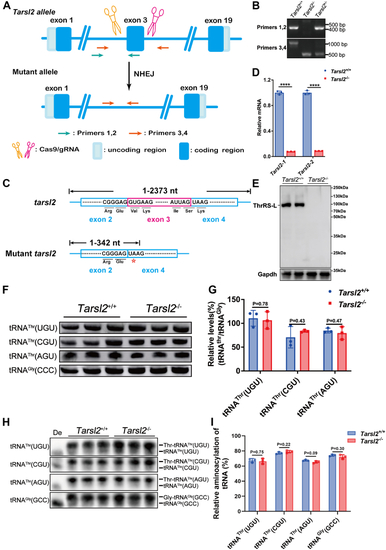Figure 3
- ID
- ZDB-FIG-230526-64
- Publication
- Zeng et al., 2023 - Loss of threonyl-tRNA synthetase-like protein Tarsl2 has little impact on protein synthesis but affects mouse development
- Other Figures
- All Figure Page
- Back to All Figure Page
|
Loss of Tarsl2 exerts no effect on the steady-state or charging of tRNAThrs in vivo.A, schematic showing Tarsl2-mutant mouse construction by CRISPR/Cas9 gene editing technology. Two sgRNAs were designed around exon 3 to delete a sequence fragment. Primers 1 and 2 and Primers 3 and 4 were used to detect DNA mutations. B, PCR detection of the Tarsl2+/+, Tarsl2+/−, and Tarsl2−/− mouse genotypes using Primers 1 and 2 and Primers 3 and 4. C, sequencing results of Tarsl2+/+ and Tarsl2−/− mice. In the mutant mice, Tarsl2 mRNA translation was prematurely terminated at nt 342. D, Tarsl2 mRNA levels in the muscle of the 6-week-old Tarsl2+/+ and Tarsl2−/− mice, as determined by RT‒PCR with two pairs of primers. E, protein abundance of Tarsl2 in the 6-week-old Tarsl2+/+ and Tarsl2−/− mouse muscle, as detected by Western blotting. Gapdh was used as the loading control. F and G, levels of tRNAThr(UGU), tRNAThr(CGU), and tRNAThr(AGU) in the muscle tissues of the 6-week-old Tarsl2+/+ and Tarsl2−/− mice. tRNAGly(CCC) was included as the loading control. H and I Aminoacylation levels of tRNAThr(UGU), tRNAThr(CGU), and tRNAThr(AGU) in the muscle tissues of the 6-week-old |

